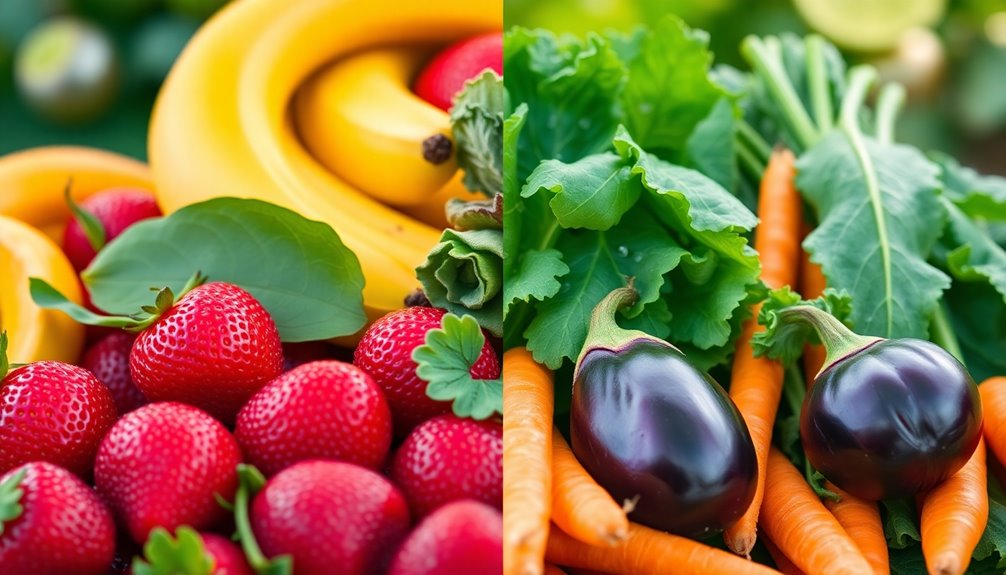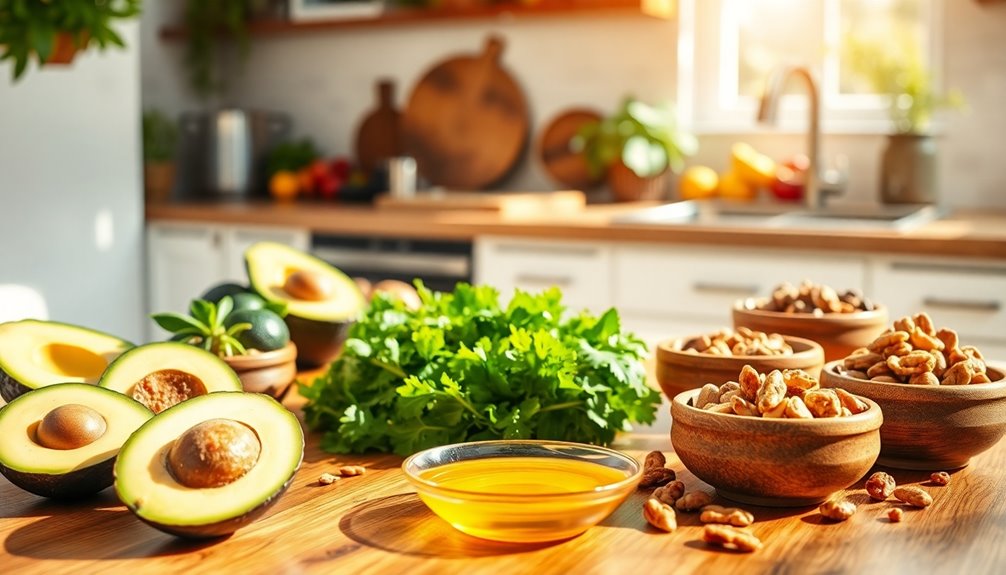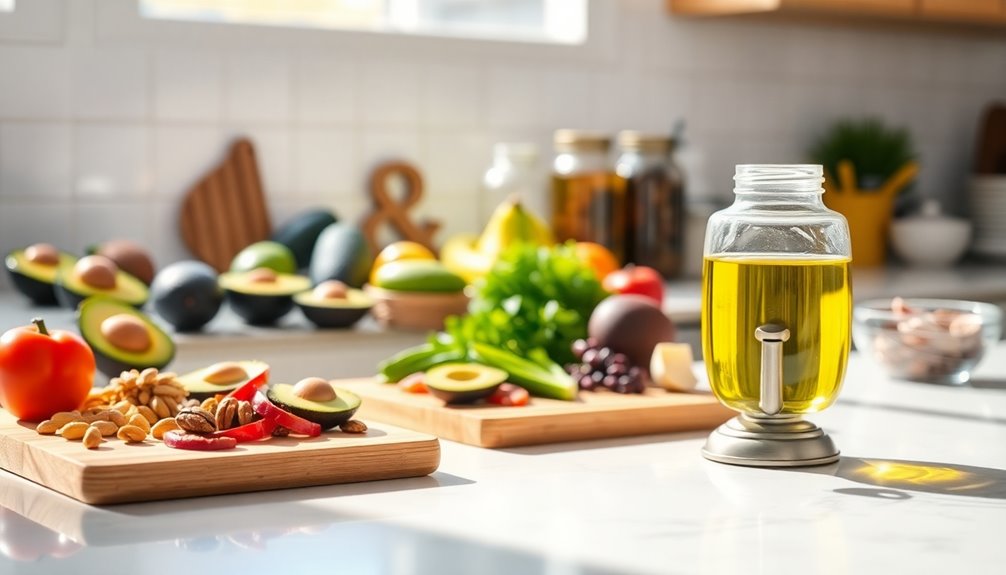When you convert 39 grams of sugar, you're looking at about 9.75 teaspoons. To manage your sugar intake, it's essential to understand this conversion. Many labels simplify this by rounding to 4 grams per teaspoon, making it easier to track what you consume. Knowing where sugar sneaks into your diet, like in sodas or snacks, can help you make healthier choices. Too much sugar increases risks for obesity, diabetes, and heart disease. By keeping an eye on your intake, you can steer clear of these health issues. Curious about more ways to reduce sugar? There's plenty more to explore!
Key Takeaways
- 39 grams of sugar equals approximately 9.75 teaspoons (39 ÷ 4 = 9.75).
- Understanding sugar content helps manage health risks like obesity and diabetes.
- Reading nutrition labels aids in tracking sugar intake effectively.
- Limiting added sugars to less than 10% of daily calories can improve health outcomes.
- Opt for whole fruits over juices to reduce sugar consumption while enjoying natural sweetness.
Understanding Sugar Measurements
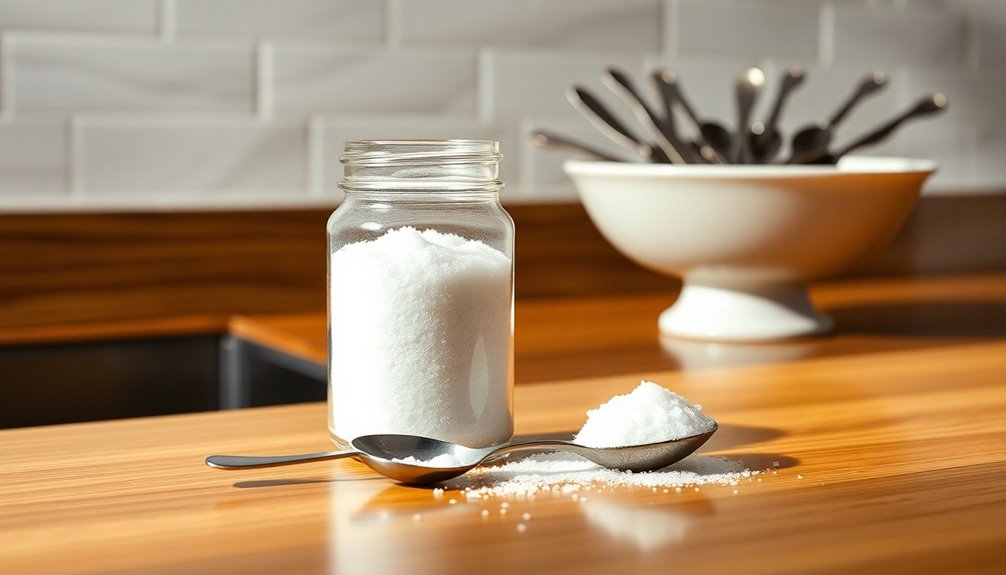
When it comes to managing your sugar intake, understanding how to convert grams to teaspoons is essential. The simple rule that four grams of sugar equals approximately one teaspoon can make a significant difference in your dietary choices. For instance, if you're looking at a food label and see 20 grams of sugar, you can easily convert that to five teaspoons of sugar by dividing 20 by 4.
Accurate sugar measurements play a vital role in your health, especially since excessive sugar intake can lead to issues like obesity and diabetes.
While many recipes might provide measurements in teaspoons, relying on grams can enhance precision. This is important since different types of sugar have varied densities, making grams a more reliable measurement for cooking and baking.
Utilizing conversion tables can further help you navigate sugar content in foods. By familiarizing yourself with these measurements, you can make more informed dietary choices, ensuring that you maintain a balanced intake of sugar.
Grams to Teaspoons Conversion
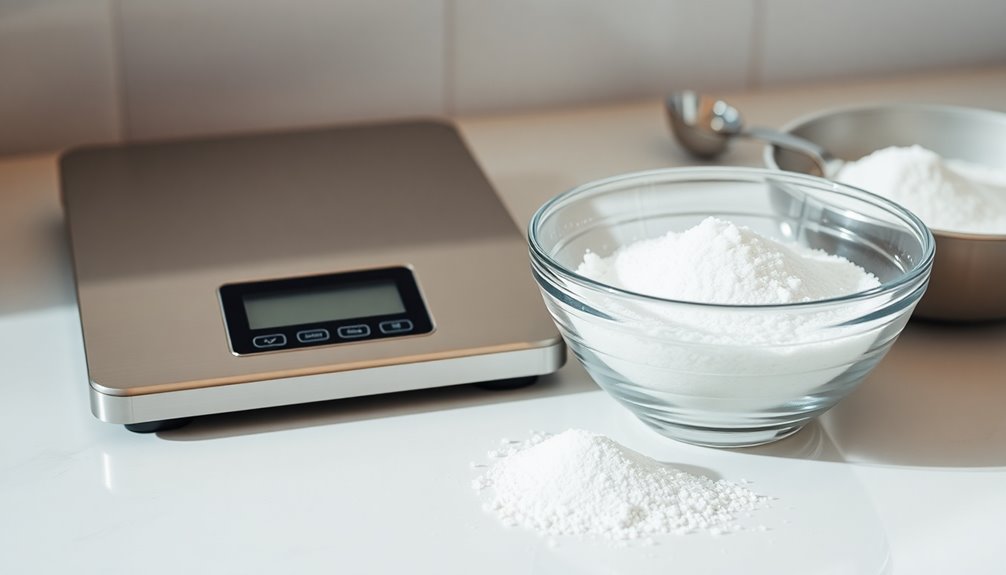
Converting grams of sugar to teaspoons is a straightforward process that empowers you to better manage your sugar intake. To make the grams to teaspoons conversion, simply divide the number of grams by 4. This is because 4 grams of sugar is roughly equal to 1 teaspoon. For instance, if you encounter a beverage containing 20 grams of sugar, you can easily determine that it's equivalent to 5 teaspoons (20 ÷ 4).
Understanding this conversion helps you visualize your sugar intake and aids in making informed dietary choices. Nutrition labels often round down to 4 grams for simplicity, which simplifies estimating the sugar content in various foods and drinks.
By using this conversion method, you can effectively manage your sugar consumption, recognizing that even small amounts of sugar can accumulate quickly over time.
Next time you check a product's sugar content, remember the grams to teaspoons conversion. Whether you're monitoring your intake for health reasons or just aiming for a balanced diet, this simple calculation can make a significant difference in how you perceive and manage your sugar consumption.
Importance of Monitoring Intake

Your health hinges on the awareness of your sugar intake, as excessive consumption can lead to serious health issues like obesity, diabetes, and cardiovascular diseases. Additionally, excessive sugar intake can reduce liver health, which is vital for overall wellness. Breast cancer risk factors also include poor dietary choices, which can contribute to overall health decline. Maintaining a healthy weight is crucial, as obesity can increase the risk of late-stage breast cancer. Moreover, incorporating inflation-protected annuities into your financial plan can help secure your retirement income against rising costs.
It's crucial to monitor the amount of sugar you consume daily, especially since the 2015-2020 Dietary Guidelines recommend limiting added sugars to less than 10% of total daily calories. For a typical 2,000-calorie diet, that means you should aim for about 50 grams or 12 teaspoons of added sugar.
Just think about it: a single can of soda packs about 40 grams of sugar, translating to 10 teaspoons. That's a huge chunk of your daily limit in one drink!
Similarly, common juices can contain around 24 grams of sugar (6 teaspoons) in just one serving.
Understanding the conversion of grams to teaspoons helps you visualize your sugar intake better. By knowing that 1 teaspoon equals 4 grams, you can make informed dietary choices. Additionally, monitoring your sugar intake can significantly improve overall health and wellness.
Keeping track of the amount of sugar in your foods and beverages will empower you to manage your health more effectively and avoid excessive consumption.
Common Sources of Sugar
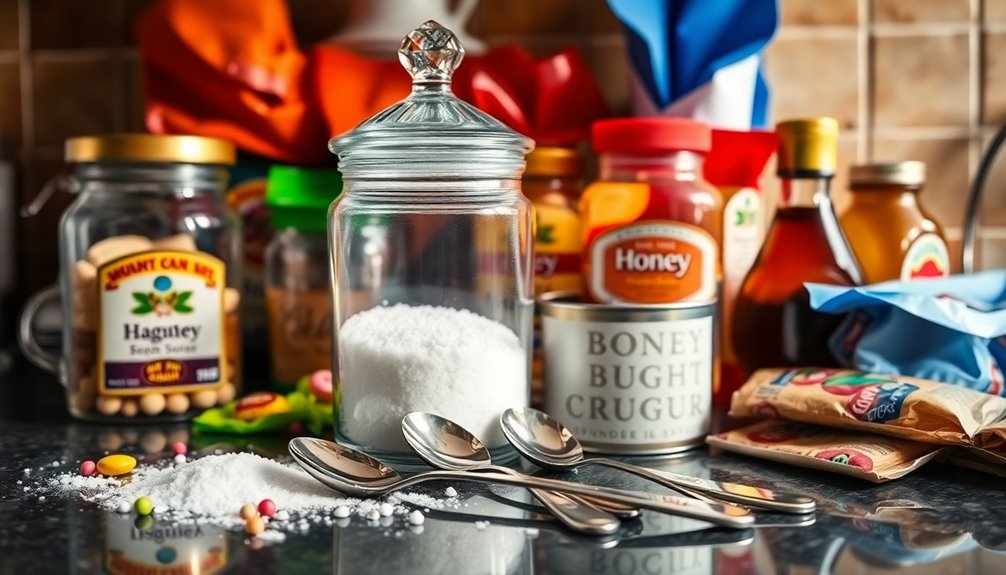
Sugar often sneaks into our diets more frequently than we realize. You might think you're making healthy choices, but many common foods and drinks are loaded with added sugars.
Sweetened beverages, like soda, can contain about 40 grams of sugar per can—this is equal to around 10 teaspoons! Even fruit juices, often labeled as healthier options, can pack about 24 grams of sugar per serving, translating to roughly 6 teaspoons.
Breakfast cereals aren't off the hook either; some varieties can exceed 10 grams of sugar per serving, which is more than 2.5 teaspoons. You might be surprised to learn that condiments like ketchup can contribute to your sugar intake too, with a single tablespoon containing around 4 grams, or 1 teaspoon of sugar.
Snack foods, such as granola bars and flavored yogurts, often have added sugars as well. Some brands might exceed 15 grams per serving, equating to about 3.75 teaspoons. Additionally, it's important to be aware of foreign transaction fees that can unexpectedly increase costs when purchasing imported products containing added sugars.
Health Risks of Excess Sugar
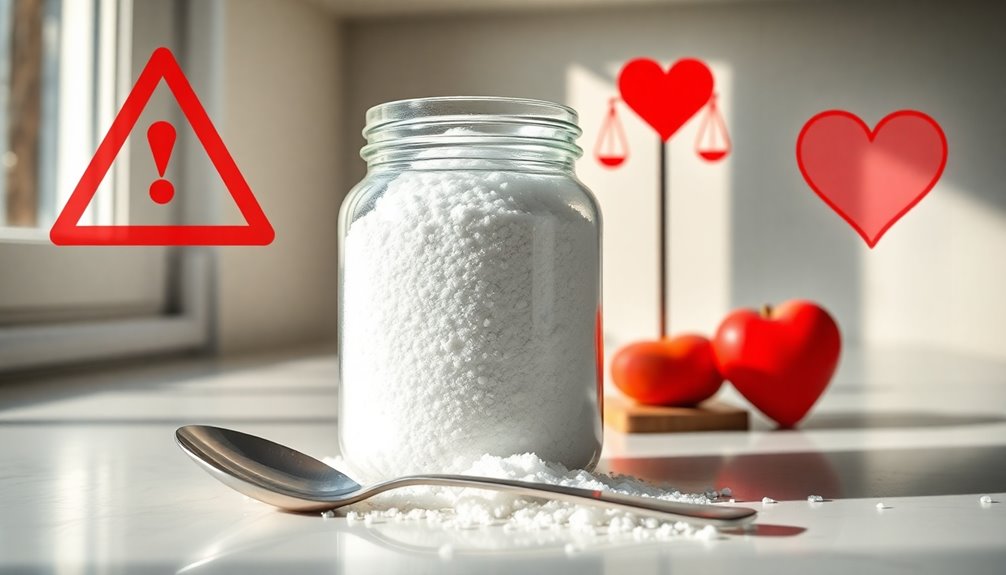
Excess sugar in your diet can notably raise your risk of diabetes, heart disease, and unwanted weight gain.
When you consume more sugar than recommended, your body struggles with insulin resistance and other metabolic issues.
It's essential to understand these health risks and consider making changes to your sugar intake for better overall wellness.
Diabetes Risk Factors
Many people may not realize that a high intake of added sugars can greatly increase the risk of developing type 2 diabetes. When you consume excessive sugar, it can lead to insulin resistance and impair your body's ability to metabolize glucose effectively. Studies reveal that if you regularly drink sugary beverages, you're at a higher risk of diabetes compared to those who keep their sugar intake in check.
Additionally, a diet rich in added sugars often contributes to obesity, a major risk factor for diabetes. These sugary foods are typically calorie-dense but lack essential nutrients, making them a poor choice for maintaining a healthy weight.
The American Heart Association recommends limiting added sugars to no more than 6 teaspoons (25 grams) per day for women and 9 teaspoons (38 grams) for men. Sticking to these guidelines can help reduce your risk.
It's also important to be aware of hidden sugars in various foods and beverages. Many products contain sugar that can quickly push you over the daily recommended limits, further raising your diabetes risk.
Heart Disease Connection
A high intake of added sugars can greatly elevate your risk of heart disease. When you consume excessive sugar, particularly from sweetened beverages, you may contribute to serious health issues like obesity, inflammation, and insulin resistance. Additionally, excessive sugar consumption can lead to higher triglyceride levels, which are a major risk factor for heart disease.
Studies reveal that if you're getting more than 25% of your daily calories from added sugars, your chances of developing cardiovascular disease increase considerably. High sugar consumption also leads to elevated triglyceride levels, which are a major risk factor for heart disease. The American Heart Association recommends limiting added sugar intake to no more than 6 teaspoons (25 grams) per day for women and 9 teaspoons (38 grams) for men.
Sticking to these guidelines can help protect your heart health. Moreover, regularly indulging in sugary foods and drinks can create a cycle of unhealthy eating patterns, making it even harder to maintain a heart-healthy lifestyle. Additionally, diversification strategy in your diet, such as incorporating more whole foods, can further enhance your overall health and reduce sugar dependency.
Weight Gain Consequences
Regularly consuming too much sugar can lead to considerable weight gain, which poses serious health risks. Excessive sugar intake is closely linked to obesity, paving the way for conditions like type 2 diabetes, cardiovascular disease, and even certain types of cancer. Sugary beverages, such as soda and juice, considerably contribute to your daily sugar intake due to their high calorie density and low satiety. Additionally, following a low carb diet can help mitigate the negative effects of sugar consumption by reducing overall carb intake. Studies show that portable camping toilets can provide convenience in outdoor settings, allowing for healthier habits even when away from home. Incorporating a retirement savings plan can also promote long-term financial health, which is essential for maintaining overall well-being. Furthermore, being mindful of hydration support through water-rich foods can help reduce cravings for sugary snacks.
To help you understand the risks associated with sugar intake, consider the following table:
| Health Risk | Sugar Intake Impact | Recommended Limit |
|---|---|---|
| Obesity | Increases weight gain | Women: 6 tsp, Men: 9 tsp |
| Insulin Resistance | Leads to metabolic syndrome | Reduce added sugars |
| Heart Disease & Diabetes | Higher risk with excess | Stay within daily limits |
The American Heart Association recommends limiting added sugar to 6 teaspoons (25 grams) for women and 9 teaspoons (36 grams) for men. Being aware of your sugar intake can help you make informed dietary choices, potentially reducing the risk of weight gain and associated health problems. Moreover, adopting a balanced diet can further assist in managing your overall health and weight effectively.
Tips for Reducing Sugar Intake

Reducing sugar intake can considerably improve your overall health and well-being. To start, aim to limit added sugars to less than 10% of your daily caloric intake, which is about 50 grams or 12 teaspoons for a 2,000-calorie diet.
One of the best ways to cut sugar is by reading nutrition labels. Be aware that 4 grams of sugar equals approximately 1 teaspoon, so you can easily track your consumption.
Instead of reaching for fruit juices, opt for whole fruits. A typical juice serving can have around 24 grams of sugar (6 teaspoons), while whole fruits offer fiber and fewer sugars per serving.
Additionally, swap out sugary beverages like soda, which can contain up to 40 grams of sugar (10 teaspoons) per can, for water or unsweetened drinks.
Finally, consider gradually reducing the sugar you add to your foods and beverages. Your taste buds can adapt over time, making it easier to enjoy less sweet options.
Nutritional Label Insights
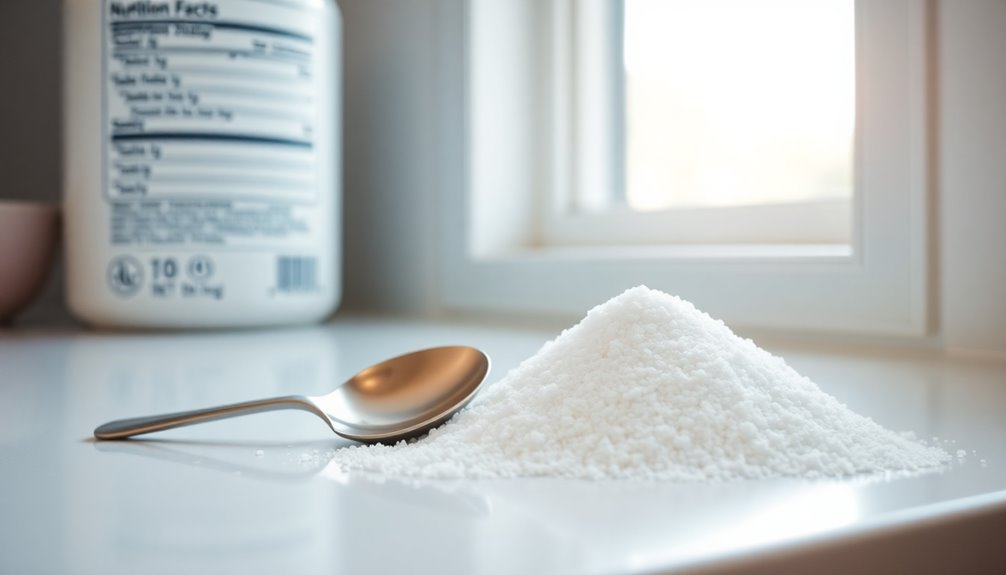
Understanding how to read nutritional labels can empower you to make healthier choices, especially when it comes to sugar consumption. Nutrition facts labels are your roadmap to understanding the sugar content in the foods you eat. They provide essential information that helps you track your sugar intake and make informed decisions.
- Serving Size: Always check this to know how much you're actually consuming.
- Total Calories: This helps gauge the overall energy you're getting from the product.
- Carbohydrates: Look for both naturally occurring sugars and added sugars.
- Added Sugars: It's important to monitor this, as dietary guidelines recommend limiting added sugar. Monitoring your nutritional intake can also play a crucial role in maintaining a balanced diet.
When you see the sugar content listed, remember that nutrition labels often round down added sugars. For example, 4 grams of sugar equals about 1 teaspoon. This makes it easier to visualize how much sugar you're consuming. Additionally, being aware of saturated fat intake can help you make more informed choices regarding overall diet quality.
Healthier Beverage Choices
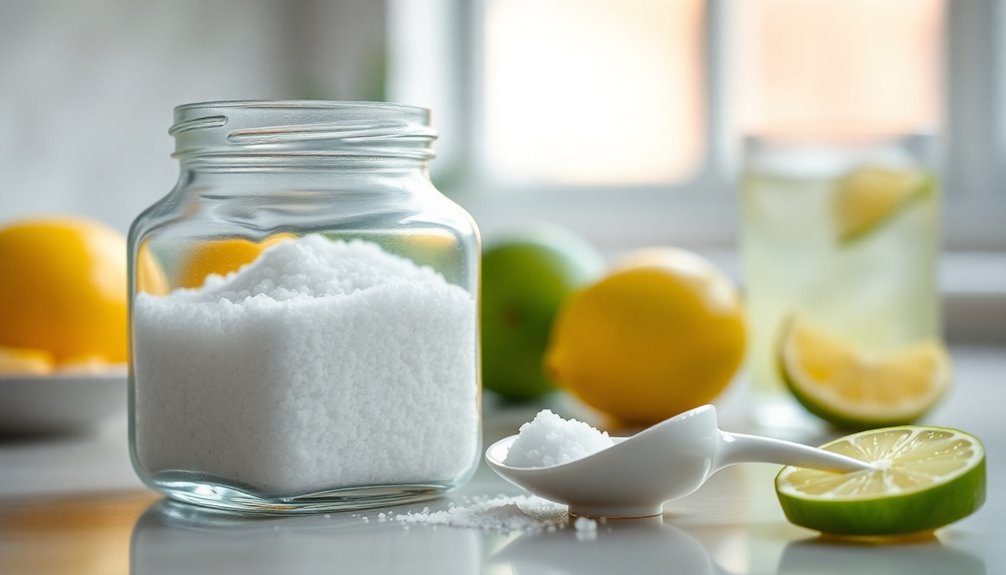
When it comes to choosing drinks, water is your best friend, offering hydration without any sugar. In contrast, many popular beverages, like soda and even fruit juices, can pack in surprising amounts of sugar that quickly add up. Americano coffee, on the other hand, is a low-calorie beverage option that can be enjoyed without added sugars, and it is also linked to improved cognitive function which can enhance your morning routine. Additionally, opting for aromatherapy products can enhance your relaxation while sipping on a healthy drink. Choosing beverages like Americano coffee aligns with current trends in Nike Tech that emphasize comfort and performance in our daily choices. Moreover, enjoying a cup of Americano can provide a caffeine boost, with a single shot of espresso containing about 120 mg of caffeine, making it a great choice to kickstart your day.
Benefits of Water Consumption
Choosing water as your primary beverage can lead to significant health benefits. By prioritizing water consumption, you're opting for a calorie-free drink that hydrates without adding any sugar to your diet. This simple choice can help you maintain a healthy weight and support essential bodily functions.
Here are some key benefits of water consumption:
- Weight Management: It replaces sugary drinks, reducing your daily sugar intake and helping prevent obesity.
- Enhanced Digestion: Staying hydrated aids digestion and guarantees your body can effectively transport nutrients.
- Cognitive and Physical Boost: Proper hydration improves cognitive function and enhances physical performance, keeping you alert and energetic.
- Temperature Regulation: Water plays an important role in regulating body temperature, especially during exercise or hot weather.
The Institute of Medicine recommends that men consume about 3.7 liters (or 15.5 cups) and women about 2.7 liters (or 11.5 cups) of water daily, including all beverages and food.
Comparing Sugar Content
In today's world of beverage choices, the sugar content in drinks can often be surprising. For example, a standard can of soda packs about 40 grams of sugar, equating to roughly 10 teaspoons. That's a hefty amount for just one drink!
Many people assume fruit juice is a better alternative, but it can contain around 24 grams of sugar per serving, which translates to 6 teaspoons. It's easy to see why juice might be misleadingly perceived as a healthier option, yet its sugar content remains significant.
To make better choices, consider water as your go-to beverage. With zero sugar, it provides essential hydration without the added calories from sugar. By increasing your awareness of the sugar content in beverages, you can steer clear of those that may lead to health issues down the line. Additionally, some coffee additives like MCT oil can enhance cognitive function and energy levels without adding unnecessary sugar.
The key is to compare your options. While juices and sodas may taste good, their sugar content can impact your health negatively.
Next time you reach for a drink, think about what you're consuming and opt for healthier choices that support your well-being. Remember, your beverage choice can make a big difference!
Nutritious Beverage Alternatives
Finding nutritious beverage alternatives can greatly improve your overall health while keeping your taste buds satisfied. By making simple switches, you can cut down on sugar and enjoy delicious drinks that hydrate and nourish your body.
Here are some great options to evaluate:
- Water: The healthiest choice, it's essential for hydration and contains zero sugar.
- Unsweetened herbal teas: These offer diverse flavors and health benefits without added sugars, and many varieties, like chamomile, are known for their calming effects. Additionally, herbal teas can be enhanced with chia seeds for added health benefits. Many herbal teas, such as hibiscus tea, also provide antioxidant properties that support overall wellness.
- Sparkling water: A revitalizing alternative to sugary sodas, it hydrates without any calories.
- Homemade fruit-infused water: Add slices of your favorite fruits to water for a burst of natural flavor without high sugar content.
Additionally, think about low-fat or non-fat milk, which provides essential nutrients like calcium and vitamin D while having less sugar than many fruit juices.
Frequently Asked Questions
How Many Grams Is 1 Tsp of Sugar?
One teaspoon of sugar contains about 4 grams.
When you measure out a teaspoon, you're actually scooping up this amount of sugar, which can be helpful when you're tracking your intake.
If you want to reduce sugar consumption, knowing this conversion lets you easily visualize how much sugar you're consuming in different foods.
Keeping an eye on these measurements can lead to healthier choices and better dietary management.
How Many Grams of Sugar a Day Is Healthy?
Imagine a sweet, tempting dessert in front of you, but you know moderation's key.
For a healthy daily intake, you should limit added sugars to about 6 teaspoons (25 grams) for women and 9 teaspoons (36 grams) for men.
Keeping your sugar intake within these limits can help you avoid health issues like obesity and diabetes, allowing you to enjoy life's sweetness without the guilt or negative consequences.
What Does 1 Gram of Sugar Look Like in Teaspoons?
When you're trying to visualize sugar, remember that 1 gram of sugar is about 0.24 teaspoons.
To make it easier, you can think of the rule of four: 4 grams equals 1 teaspoon.
So, if you see a product with 8 grams of sugar, that's roughly 2 teaspoons.
Keeping track of these measurements helps you make better dietary choices and manage your sugar intake more effectively.
How to Convert Grams of Sugar to Teaspoons?
Converting grams of sugar to teaspoons is as easy as pie! Just take the number of grams and divide it by 4.
For instance, if you've got 32 grams of sugar, you'll find that's 8 teaspoons (32 ÷ 4 = 8).
This simple trick makes tracking your sugar intake a breeze and helps you make healthier choices.
Conclusion
By keeping an eye on your sugar intake and knowing that 39 grams equals about 9.5 teaspoons, you can make healthier choices that'll transform your diet like a magic wand! Staying informed about common sugar sources and reading nutritional labels empowers you to cut back effectively. Remember, every small change counts—it's like taking a step toward a healthier you. So, go ahead and swap those sugary drinks for better options; your body will thank you!



